Chromatographic-Based Platforms as New Avenues for Scientific Progress and Sustainability
Abstract
:1. Introduction
1.1. History and Evolution
1.2. Principle of Chromatography and Types of Chromatography
1.2.1. Gas Chromatography
1.2.2. Liquid Chromatography
1.3. Major Achievements
2. Contributions of Chromatography to the Science Progress
2.1. Chromatography Helping in Societal Challenges
2.1.1. Chromatography-Based Metabolomics Utility to Unveil Disease and/or Physiological Status
2.1.2. The Role of Chromatography to Respond Current Agri-Food Industries Challenges and Sustainability
2.1.3. Using Chromatography to Monitor Environmental Contaminants
3. Final Remarks
Author Contributions
Funding
Institutional Review Board Statement
Informed Consent Statement
Data Availability Statement
Acknowledgments
Conflicts of Interest
Sample Availability
Abbreviations
References
- IUPAC. Compendium of Chemical Terminology. In Gold Book, 2nd ed.; McNaught, A.D., Wilkinson, A., Eds.; Blackwell Scientific Publications: Hoboken, NJ, USA, 2019. [Google Scholar] [CrossRef]
- Runge, F.F. Ueber einige Produkte der Steinkohlendestillation. Ann. Phys. 1834, 107, 65–78. [Google Scholar] [CrossRef]
- Bussemas, H.H.; Ettre, L.S. Forerunners of chromatography: Runge’s self-grown pictures. LC-GC N. Am. 2004, 22, 262. [Google Scholar]
- Kritchevsky, D. Friedrich Goppelsroeder: Pioneer of paper chromatography. J. Chem. Educ. 1959, 36, 196. [Google Scholar] [CrossRef]
- Yashin, Y.I.; Yashin, A.Y. Contribution of Russian Experts to the Development of High-Performance Liquid Chromatography. J. Anal. Chem. 2020, 75, 1252–1263. [Google Scholar] [CrossRef]
- Ettre, L.S.; Hinshaw, J.V. Chapters in the Evolution of Chromatography; Imperial College Press: London, UK, 2008; pp. 76–85. [Google Scholar] [CrossRef]
- Martin, A.J.P.; Synge, R.L.M. A new form of chromatogram employing two liquid phases: A theory of chromatography. 2. Appli-cation to the micro-determination of the higher monoamino-acids in proteins. Biochem. J. 1941, 35, 1358–1368. [Google Scholar] [CrossRef]
- Horvath, C.G.; Lipsky, S.R. Use of Liquid Ion Exchange Chromatography for the Separation of Organic Compounds. Nature 1966, 211, 748–749. [Google Scholar] [CrossRef] [PubMed]
- Horvath, C.G.; Preiss, B.A.; Lipsky, S.R. Fast liquid chromatography: An Investigation of operating parameters and the separation of nucleotides on pellicular ion exchangers. Anal. Chem. 1967, 39, 1422–1428. [Google Scholar] [CrossRef]
- Arnaud, C.H. 50 years of HPLC. C&EN Glob. Enterp. 2016, 94, 28–33. [Google Scholar] [CrossRef]
- Davankov, V.A. 50 years of chiral liquid Chromatography. How it started. J. Chromatogr. A 2022, 1668, 462910. [Google Scholar] [CrossRef]
- Ismail, B.; Nielsen, S.S. Basic Principles of Chromatography. In Food Analysis; Nielsen, S.S., Ed.; Springer: Boston, MA, USA, 2010; pp. 473–498. [Google Scholar] [CrossRef]
- Coskun, O. Separation Tecniques: Chromatography. North. Clin. Istanb. 2016, 3, 156–160. [Google Scholar] [CrossRef]
- Guiochon, G.; Guillemin, C.L. Chapter 8 Methodology Open Tubular Columns. In Journal of Chromatography Library; Guiochon, G., Guillemin, C.L., Eds.; Elsevier: Amsterdam, The Netherlands, 1988; Volume 42, pp. 247–317. [Google Scholar]
- Bruno, T.J. A Review of Capillary and Packed Column Gas Chromatographs. Sep. Purif. Methods 2000, 29, 27–61. [Google Scholar] [CrossRef]
- Wang, M.; Zhang, Y.; Wang, R.; Wang, Z.; Yang, B.; Kuang, H. An Evolving Technology That Integrates Classical Methods with Continuous Technological Developments: Thin-Layer Chromatography Bioautography. Molecules 2021, 26, 4647. [Google Scholar] [CrossRef] [PubMed]
- Medina, D.A.V.; Maciel, E.V.S.; de Toffoli, A.L.; Lanças, F.M. Miniaturization of liquid chromatography coupled to mass spectrometry. TrAC Trends Anal. Chem. 2020, 128, 115910. [Google Scholar] [CrossRef]
- Picó, Y. Chromatography–mass spectrometry: Recent evolution and current trends in environmental science. Curr. Opin. Environ. Sci. Health 2020, 18, 47–53. [Google Scholar] [CrossRef]
- Perez-Palacios, T.; Solomando, J.C.; Ruiz-Carrascal, J.; Antequera, T. Improvements in the methodology for fatty acids analysis in meat products: One-stage transmethylation and fast-GC method. Food Chem. 2021, 371, 130995. [Google Scholar] [CrossRef]
- Paolini, M.; Tonidandel, L.; Larcher, R. Development, validation and application of a fast GC-FID method for the analysis of volatile compounds in spirit drinks and wine. Food Control 2022, 136, 108873. [Google Scholar] [CrossRef]
- Fialkov, A.B.; Lehotay, S.J.; Amirav, A. Less than one minute low-pressure gas chromatography—mass spectrometry. J. Chromatogr. A 2020, 1612, 460691. [Google Scholar] [CrossRef]
- Cielecka-Piontek, J.; Zalewski, P.; Jelińska, A.; Garbacki, P. UHPLC: The Greening Face of Liquid Chromatography. Chromatographia 2013, 76, 1429–1437. [Google Scholar] [CrossRef]
- Zhao, X.; Wang, B.; Xie, K.; Liu, J.; Zhang, Y.; Wang, Y.; Guo, Y.; Zhang, G.; Dai, G.; Wang, J. Development and comparison of HPLC-MS/MS and UPLC-MS/MS methods for determining eight coccidiostats in beef. J. Chromatogr. B Analyt. Technol. Biomed. Life. Sci. 2018, 1087–1088, 98–107. [Google Scholar] [CrossRef]
- Sun, S.; Liu, M.; He, J.; Li, K.; Zhang, X.; Yin, G. Identification and Determination of Seven Phenolic Acids in Brazilian Green Propolis by UPLC-ESI-QTOF-MS and HPLC. Molecules 2019, 24, 1791. [Google Scholar] [CrossRef]
- Ponce-Rodríguez, H.; Verdú-Andrés, J.; Herráez-Hernández, R.; Campíns-Falcó, P. Exploring hand-portable nano-liquid chromatography for in place water analysis: Determination of trimethylxanthines as a use case. Sci. Total Environ. 2020, 747, 140966. [Google Scholar] [CrossRef] [PubMed]
- Piendl, S.K.; Raddatz, C.-R.; Hartner, N.T.; Thoben, C.; Warias, R.; Zimmermann, S.; Belder, D. 2D in Seconds: Coupling of Chip-HPLC with Ion Mobility Spectrometry. Anal. Chem. 2019, 91, 7613–7620. [Google Scholar] [CrossRef] [PubMed]
- Lam, S.C.; Coates, L.J.; Hemida, M.; Gupta, V.; Haddad, P.R.; Macka, M.; Paull, B. Miniature and fully portable gradient capillary liquid chromatograph. Anal. Chim. Acta 2020, 1101, 199–210. [Google Scholar] [CrossRef] [PubMed]
- Whiting, J.J.; Myers, E.; Manginell, R.P.; Moorman, M.W.; Anderson, J.; Fix, C.S.; Washburn, C.; Staton, A.; Porter, D.; Graf, D.; et al. A high-speed, high-performance, microfabricated comprehensive two-dimensional gas chromatograph. Lab Chip 2019, 19, 1633–1643. [Google Scholar] [CrossRef]
- Acevedo, M.S.M.; Gama, M.R.; Batista, A.; Rocha, F.R. Two-dimensional separation by sequential injection chromatography. J. Chromatogr. A 2020, 1626, 461365. [Google Scholar] [CrossRef]
- Salter, T.L.; Magee, B.A.; Waite, J.H.; Sephton, M.A. Mass Spectrometric Fingerprints of Bacteria and Archaea for Life Detection on Icy Moons. Astrobiology 2022, 22, 143–157. [Google Scholar] [CrossRef]
- Leseigneur, G.; Bredehöft, J.H.; Gautier, T.; Giri, C.; Krüger, H.; MacDermott, A.J.; Meierhenrich, U.J.; Caro, G.M.M.; Raulin, F.; Steele, A.; et al. COSAC’s Only Gas Chromatogram Taken on Comet 67P/Churyumov-Gerasimenko. ChemPlusChem 2022, 87, e202200116. [Google Scholar] [CrossRef]
- Cassaro, A.; Pacelli, C.; Baqué, M.; Cavalazzi, B.; Gasparotto, G.; Saladino, R.; Botta, L.; Böttger, U.; Rabbow, E.; de Vera, J.; et al. Investigation of fungal biomolecules after Low Earth Orbit exposure: A testbed for the next Moon missions. Environ. Microbiol. 2022, 24, 2938–2950. [Google Scholar] [CrossRef]
- Silva, C.L.; Perestrelo, R.; Capelinha, F.; Tomás, H.; Câmara, J.S. An integrative approach based on GC–qMS and NMR metabolomics data as a comprehensive strategy to search potential breast cancer biomarkers. Metabolomics 2021, 17, 72. [Google Scholar] [CrossRef]
- Lee, H.; Kang, S.J.; Lee, J.; Park, K.H.; Rhee, W.J. Isolation and Characterization of Urinary Extracellular Vesicles from Healthy Donors and Patients with Castration-Resistant Prostate Cancer. Int. J. Mol. Sci. 2022, 23, 7134. [Google Scholar] [CrossRef]
- Telleria, O.; Alboniga, O.E.; Clos-Garcia, M.; Nafría-Jimenez, B.; Cubiella, J.; Bujanda, L.; Falcón-Pérez, J.M. A Comprehensive Metabolomics Analysis of Fecal Samples from Advanced Adenoma and Colorectal Cancer Patients. Metabolites 2022, 12, 550. [Google Scholar] [CrossRef] [PubMed]
- Avataneo, V.; De Nicolò, A.; Cusato, J.; Antonucci, M.; Manca, A.; Palermiti, A.; Waitt, C.; Walimbwa, S.; Lamorde, M.; Di Perri, G.; et al. Development and validation of a UHPLC-MS/MS method for quantification of the prodrug remdesivir and its metabolite GS-441524: A tool for clinical pharmacokinetics of SARS-CoV-2/COVID-19 and Ebola virus disease. J. Antimicrob. Chemother. 2020, 75, 1772–1777. [Google Scholar] [CrossRef] [PubMed]
- Viode, A.; Smolen, K.K.; Fatou, B.; Wurie, Z.; Van Zalm, P.; Konde, M.K.; Keita, B.M.; Ablam, R.A.; Fish, E.N.; Steen, H. Plasma Proteomic Analysis Distinguishes Severity Outcomes of Human Ebola Virus Disease. mBio 2022, 13, e0056722. [Google Scholar] [CrossRef] [PubMed]
- Ahmed, N.; Kidane, B.; Wang, L.; Nugent, Z.; Moldovan, N.; McElrea, A.; Shariati-Ievari, S.; Qing, G.; Tan, L.; Buduhan, G.; et al. Metabolic Alterations in Sputum and Exhaled Breath Condensate of Early Stage Non-Small Cell Lung Cancer Patients After Surgical Resection: A Pilot Study. Front. Oncol. 2022, 12, 874964. [Google Scholar] [CrossRef]
- Bargaje, M.; Bharaswadkar, S.; Lohidasan, S.; Panda, B.K. Plasma drug concentrations of 4-drug fixed-dose combination regimen and its efficacy for treatment of pulmonary tuberculosis under National Tuberculosis Elimination Programme: A prospective pilot study. Indian J. Tuberc. 2021, 69, 311–319. [Google Scholar] [CrossRef]
- Cozzolino, R.; Stocchero, M.; Perestrelo, R.; Câmara, J.S. Comprehensive Evaluation of the Volatomic Fingerprint of Saffron from Campania towards Its Authenticity and Quality. Foods 2022, 11, 366. [Google Scholar] [CrossRef]
- Yang, J.; Wilson, I.; Rainville, P. Evaluation of hybrid surface technology for the analysis of the B-group vitamins by LC-ESI-MS/MS. J. Chromatogr. B Analyt. Technol. Biomed. Life. Sci. 2022, 1204, 123336. [Google Scholar] [CrossRef]
- Liu, X.; Tian, X.; Qinghong, S.; Sun, H.; Jing, L.; Tang, X.; Guo, Z.; Liu, Y.; Wang, Y.; Ma, J.; et al. Characterization of LC-MS based urine metabolomics in healthy children and adults. PeerJ 2022, 10, e13545. [Google Scholar] [CrossRef]
- Muresan, A.A.; Rusu, A.; Roman, G.; Bala, C. Metabolomic Analysis of Normal Weight, Healthy and Unhealthy Obesity: Amino Acid Change Across the Spectrum of Metabolic Wellbeing in Women. Acta Endocrinol. 2021, 17, 427–431. [Google Scholar] [CrossRef]
- Kheiri, A.; Aliakbarlu, J.; Tahmasebi, R. Antioxidant potential and fatty acid profile of fish fillet: Effects of season and fish species. Vet. Res. Forum 2022, 13, 91–99. [Google Scholar] [CrossRef]
- Luo, B.; Lv, J.; Li, K.; Liao, P.; Chen, P. Structural Characterization and Anti-inflammatory Activity of a Galactorhamnan Polysaccharide from Citrus medica L. var. sarcodactylis. Front. Nutr. 2022, 9, 916976. [Google Scholar] [CrossRef] [PubMed]
- Dhanshetty, M.; Shinde, R.; Goon, A.; Oulkar, D.; Elliott, C.T.; Banerjee, K. Analysis of aflatoxins and ochratoxin a in chilli powder using ultrahigh performance liquid chromatography with fluorescence detection and tandem mass spectrometry. Mycotoxin Res. 2022, 38, 193–203. [Google Scholar] [CrossRef] [PubMed]
- Medina, S.; Perestrelo, R.; Silva, P.; Pereira, J.A.; Câmara, J.S. Current trends and recent advances on food authenticity technologies and chemometric approaches. Trends Food Sci. Technol. 2019, 85, 163–176. [Google Scholar] [CrossRef]
- Focker, M.; Borne, B.H.P.; Fischer, M.; Schuh, E.; Mader, A.; Andersson, M.G.; Ali, B.M.; Fels-Klerx, H.J. Interactions between risk assessors and risk managers during three major food incidents in Europe. J. Food Sci. 2021, 86, 3611–3627. [Google Scholar] [CrossRef] [PubMed]
- Ádám, A.L.; Kátay, G.; Künstler, A.; Király, L. Detection of Lipid Peroxidation-Derived Free Azelaic Acid, a Biotic Stress Marker and Other Dicarboxylic Acids in Tobacco by Reversed-Phase HPLC-MS Under Non-derivatized Conditions. Methods Mol. Biol. 2022, 2526, 191–200. [Google Scholar] [CrossRef]
- Niimi, J.; Deveau, A.; Splivallo, R. Geographical-based variations in white truffle Tuber magnatum aroma is explained by quantitative differences in key volatile compounds. New Phytol. 2021, 230, 1623–1638. [Google Scholar] [CrossRef]
- Omeje, J.S.; Asegbeloyin, J.N.; Ihedioha, J.N.; Ekere, N.R.; Ochonogor, A.E.; Abugu, H.O.; Alum, O.L. Monitoring of pesticide residues in fresh fruits and vegetables available in Nigerian markets and assessment of their associated health risks. Environ. Monit. Assess. 2022, 194, 516. [Google Scholar] [CrossRef]
- Rawat, S.; Singh, J. Synthesis of nZnO from waste batteries by hydrometallurgical method for photocatalytic degradation of organic pollutants under visible light irradiation. J. Environ. Manag. 2022, 318, 115518. [Google Scholar] [CrossRef]
- Yang, J.; Zhang, G.; Wang, Z.; Meng, J.; Wen, H. Metabolic Study of Stable Isotope Labeled Indolinone Derivative in Hepatocyte Cell by UPLC/Q TOF MS. J. Am. Soc. Mass Spectrom. 2021, 32, 1538–1544. [Google Scholar] [CrossRef]
- Zeng, W.; Lao, S.; Guo, Y.; Wu, Y.; Huang, M.; Tomlinson, B.; Zhong, G. The Influence of EGCG on the Pharmacokinetics and Pharmacodynamics of Bisoprolol and a New Method for Simultaneous Determination of EGCG and Bisoprolol in Rat Plasma. Front. Nutr. 2022, 9, 907986. [Google Scholar] [CrossRef]
- Amaral, M.S.S.; Nolvachai, Y.; Marriott, P.J. Comprehensive Two-Dimensional Gas Chromatography Advances in Technology and Applications: Biennial Update. Anal. Chem. 2020, 92, 85–104. [Google Scholar] [CrossRef]
- Stoll, D.R.; Carr, P.W. Two-Dimensional Liquid Chromatography: A State of the Art Tutorial. Anal. Chem. 2017, 89, 519–531. [Google Scholar] [CrossRef]
- Erjavec, G.N.; Konjevod, M.; Perkovic, M.N.; Strac, D.S.; Tudor, L.; Barbas, C.; Grune, T.; Zarkovic, N.; Pivac, N. Short overview on metabolomic approach and redox changes in psychiatric disorders. Redox Biol. 2018, 14, 178–186. [Google Scholar] [CrossRef]
- Sundekilde, U.K.; Yde, C.C.; Honore, A.H.; Rae, J.M.C.; Burns, F.R.; Mukerji, P.; Mawn, M.P.; Stenman, L.; Dragan, Y.; Glover, K.; et al. An Integrated Multi-Omics Analysis Defines Key Pathway Alterations in a Diet-Induced Obesity Mouse Model. Metabolites 2020, 10, 80. [Google Scholar] [CrossRef]
- Alonso, A.; Marsal, S.; Juliã, A. Analytical Methods in Untargeted Metabolomics: State of the Art in 2015. Front. Bioeng. Biotechnol. 2015, 3, 23. [Google Scholar] [CrossRef]
- Ahmed, Z. Practicing precision medicine with intelligently integrative clinical and multi-omics data analysis. Hum. Genom. 2020, 14, 35. [Google Scholar] [CrossRef]
- Branco, I.; Choupina, A. Bioinformatics: New tools and applications in life science and personalized medicine. Appl. Microbiol. Biotechnol. 2021, 105, 937–951. [Google Scholar] [CrossRef]
- Mattrey, F.T.; Makarov, A.A.; Regalado, E.L.; Bernardoni, F.; Figus, M.; Hicks, M.B.; Zheng, J.; Wang, L.; Schafer, W.; Antonucci, V.; et al. Current challenges and future prospects in chromatographic method development for pharmaceutical research. TrAC Trends Anal. Chem. 2017, 95, 36–46. [Google Scholar] [CrossRef]
- Fu, W.; Xu, L.; Yu, Q.; Fang, J.; Zhao, G.; Li, Y.; Pan, C.; Dong, H.; Wang, D.; Ren, H.; et al. Artificial Intelligent Olfactory System for the Diagnosis of Parkinson’s Disease. ACS Omega 2022, 7, 4001–4010. [Google Scholar] [CrossRef]
- Costa, C.P.; Marques, J.; Silva, D.; Barbosa, C.; Oliveira, A.S.; Santos, M.; Rocha, S.M. Metabolomics Profiling of Human Exhaled Breath Condensate by SPME/GC×GC-ToFMS: Exploratory study on the use of face masks at the level of lipid peroxidation volatile markers. Microchem. J. 2021, 171, 106830. [Google Scholar] [CrossRef]
- Caldeira, M.; Perestrelo, R.; Barros, A.; Bilelo, M.; Morête, A.; Câmara, J.; Rocha, S. Allergic asthma exhaled breath metabolome: A challenge for comprehensive two-dimensional gas chromatography. J. Chromatogr. A 2012, 1254, 87–97. [Google Scholar] [CrossRef]
- Bosona, T.; Gebresenbet, G. Swedish Consumers’ Perception of Food Quality and Sustainability in Relation to Organic Food Production. Foods 2018, 7, 54. [Google Scholar] [CrossRef]
- Lauterbach, J.; Bantle, C. “For More Diversity, Better Taste and My Own Health” Exploring Organic Consumers’ Purchasing Motives for Heirloom Vegetable Varieties. Sustainability 2022, 14, 4068. [Google Scholar] [CrossRef]
- Saadat, S.; Pandya, H.; Dey, A.; Rawtani, D. Food forensics: Techniques for authenticity determination of food products. Forensic Sci. Int. 2022, 333, 111243. [Google Scholar] [CrossRef]
- Stenmarck, Å.; Jensen, C.; Quested, T.; Moates, G.; Cseh, B.; Juul, S.; Parry, A.; Politano, A.; Redlingshofer, B.; Scherhaufer, S.; et al. Estimates of European Food Waste Levels—Fusions EU Project; IVL Swedish Environmental Research Institute: Stockholm, Sweden, 2014; pp. 1–80. [Google Scholar]
- Difonzo, G.; de Gennaro, G.; Pasqualone, A.; Caponio, F. Potential use of plant-based by-products and waste to improve the quality of gluten-free foods. J. Sci. Food Agric. 2022, 102, 2199–2211. [Google Scholar] [CrossRef]
- Gil-Martín, E.; Forbes-Hernández, T.; Romero, A.; Cianciosi, D.; Giampieri, F.; Battino, M. Influence of the extraction method on the recovery of bioactive phenolic compounds from food industry by-products. Food Chem. 2022, 378, 131918. [Google Scholar] [CrossRef]
- Patra, A.; Abdullah, S.; Pradhan, R.C. Review on the extraction of bioactive compounds and characterization of fruit industry by-products. Bioresour. Bioprocess. 2022, 9, 14. [Google Scholar] [CrossRef]
- Tapia-Quirós, P.; Montenegro-Landívar, M.F.; Reig, M.; Vecino, X.; Cortina, J.L.; Saurina, J.; Granados, M. Recovery of Polyphenols from Agri-Food By-Products: The Olive Oil and Winery Industries Cases. Foods 2022, 11, 362. [Google Scholar] [CrossRef]
- Rocha, S.M.; Costa, C.P.; Martins, C. Aroma Clouds of Foods: A Step Forward to Unveil Food Aroma Complexity Using GC × GC. Front. Chem. 2022, 10, 820749. [Google Scholar] [CrossRef]
- Medina, S.; Perestrelo, R.; Pereira, R.; Câmara, J.S. Evaluation of Volatilomic Fingerprint from Apple Fruits to Ciders: A Useful Tool to Find Putative Biomarkers for Each Apple Variety. Foods 2020, 9, 1830. [Google Scholar] [CrossRef]
- Bento-Silva, A.; Duarte, N.; Santos, M.; Costa, C.P.; Patto, M.C.V.; Rocha, S.M.; Bronze, M.R. Comprehensive Two-Dimensional Gas Chromatography as a Powerful Strategy for the Exploration of Broas Volatile Composition. Molecules 2022, 27, 2728. [Google Scholar] [CrossRef]
- Perestrelo, R.; Barros, A.S.; Rocha, S.M.; Câmara, J.S. Establishment of the varietal profile of Vitis vinifera L. grape varieties from different geographical regions based on HS-SPME/GC–qMS combined with chemometric tools. Microchem. J. 2014, 116, 107–117. [Google Scholar] [CrossRef]
- Petronilho, S.; Rudnitskaya, A.; Coimbra, M.; Rocha, S. Comprehensive Study of Variety Oenological Potential Using Statistic Tools for the Efficient Use of Non-Renewable Resources. Appl. Sci. 2021, 11, 4003. [Google Scholar] [CrossRef]
- Fernandes, S.; Gois, A.; Mendes, F.; Perestrelo, R.; Medina, S.; Câmara, J.S. Typicality Assessment of Onions (Allium cepa) from Different Geographical Regions Based on the Volatile Signature and Chemometric Tools. Foods 2020, 9, 375. [Google Scholar] [CrossRef]
- Quintanilla-Casas, B.; Torres-Cobos, B.; Guardiola, F.; Servili, M.; Alonso-Salces, R.M.; Valli, E.; Bendini, A.; Toschi, T.G.; Vichi, S.; Tres, A. Geographical authentication of virgin olive oil by GC–MS sesquiterpene hydrocarbon fingerprint: Verifying EU and single country label-declaration. Food Chem. 2022, 378, 132104. [Google Scholar] [CrossRef]
- Silva, I.; Coimbra, M.A.; Barros, A.; Marriott, P.; Rocha, S.M. Can volatile organic compounds be markers of sea salt? Food Chem. 2015, 169, 102–113. [Google Scholar] [CrossRef]
- Asimi, S.; Ren, X.; Zhang, M.; Li, S.; Guan, L.; Wang, Z.; Liang, S.; Wang, Z. Fingerprinting of Volatile Organic Compounds for the Geographical Discrimination of Rice Samples from Northeast China. Foods 2022, 11, 1695. [Google Scholar] [CrossRef]
- Zhao, Q.; Xi, J.; Xu, D.; Jin, Y.; Wu, F.; Tong, Q.; Yin, Y.; Xu, X. A comparative HS-SPME/GC-MS-based metabolomics approach for discriminating selected japonica rice varieties from different regions of China in raw and cooked form. Food Chem. 2022, 385, 132701. [Google Scholar] [CrossRef]
- Kalogiouri, N.P.; Manousi, N.; Paraskevopoulou, A.; Mourtzinos, I.; Zachariadis, G.A.; Rosenberg, E. Headspace Solid-Phase Microextraction Followed by Gas Chromatography-Mass Spectrometry as a Powerful Analytical Tool for the Discrimination of Truffle Species According to Their Volatiles. Front. Nutr. 2022, 9, 856250. [Google Scholar] [CrossRef]
- Wang, C.; Zhang, W.; Li, H.; Mao, J.; Guo, C.; Ding, R.; Wang, Y.; Fang, L.; Chen, Z.; Yang, G. Analysis of Volatile Compounds in Pears by HS-SPME-GC×GC-TOFMS. Molecules 2019, 24, 1795. [Google Scholar] [CrossRef]
- Capetti, F.; Marengo, A.; Cagliero, C.; Liberto, E.; Bicchi, C.; Rubiolo, P.; Sgorbini, B. Adulteration of Essential Oils: A Multitask Issue for Quality Control. Three Case Studies: Lavandula angustifolia Mill., Citrus limon (L.) Osbeck and Melaleuca alternifolia (Maiden & Betche) Cheel. Molecules 2021, 26, 5610. [Google Scholar] [CrossRef]
- Ojha, P.K.; Poudel, D.K.; Dangol, S.; Rokaya, A.; Timsina, S.; Satyal, P.; Setzer, W.N. Volatile Constituent Analysis of Wintergreen Essential Oil and Comparison with Synthetic Methyl Salicylate for Authentication. Plants 2022, 11, 1090. [Google Scholar] [CrossRef]
- Ma, W.; Zhu, Y.; Shi, J.; Wang, J.; Wang, M.; Shao, C.; Yan, H.; Lin, Z.; Lv, H. Insight into the volatile profiles of four types of dark teas obtained from the same dark raw tea material. Food Chem. 2021, 346, 128906. [Google Scholar] [CrossRef]
- Zhu, Y.; Yan, H.; Zhang, Z.-F.; Zeng, J.-M.; Zhang, Y.; Wang, J.-T.; Ma, W.-J.; Wang, M.-Q.; Peng, Q.-H.; Lv, H.-P.; et al. Assessment of the contribution of chiral odorants to aroma property of baked green teas using an efficient sequential stir bar sorptive extraction approach. Food Chem. 2021, 365, 130615. [Google Scholar] [CrossRef]
- Khvalbota, L.; Machyňáková, A.; Čuchorová, J.; Furdíková, K.; Špánik, I. Enantiomer composition of chiral compounds present in traditional Slovak Tokaj wines. J. Food Compos. Anal. 2020, 96, 103719. [Google Scholar] [CrossRef]
- Langen, J.; Wegmann-Herr, P.; Schmarr, H.-G. Quantitative determination of α-ionone, β-ionone, and β-damascenone and enantiodifferentiation of α-ionone in wine for authenticity control using multidimensional gas chromatography with tandem mass spectrometric detection. Anal. Bioanal. Chem. 2016, 408, 6483–6496. [Google Scholar] [CrossRef]
- Elbashir, A.A.; Aboul-Enein, H.Y. Multidimensional Gas Chromatography for Chiral Analysis. Crit. Rev. Anal. Chem. 2018, 48, 416–427. [Google Scholar] [CrossRef]
- Bejar, E. Adulteration of tea tree oil (Melaleuca alternifolia and M. linariifolia). Bot. Adulterants Bull. 2017, 1–8. Available online: https://www.melaleuca-alternifolia.com/kaufen/BAP-BABs-TTO-CC-v5.pdf (accessed on 28 July 2022).
- Wong, Y.F.; West, R.N.; Chin, S.-T.; Marriott, P.J. Evaluation of fast enantioselective multidimensional gas chromatography methods for monoterpenic compounds: Authenticity control of Australian tea tree oil. J. Chromatogr. A 2015, 1406, 307–315. [Google Scholar] [CrossRef]
- ISO 4730:2017/Amd 1:2018; Essential oil of Melaleuca, Terpinen-4-Ol Type (Tea Tree Oil). ISO: Geneva, Switzerland, 2018.
- Campmajó, G.; Núñez, N.; Núñez, O. The role of liquid chromatography-Mass spectrometry in food integrity and authenticity. In Mass Spectrometry—Future Perceptions and Applications Substances; Kamble, G.S., Ed.; IntechOpen: London, UK, 2019; pp. 3–20. ISBN 978-953-51-7845-3. [Google Scholar]
- Guijarro-Díez, M.; Castro-Puyana, M.; Crego, A.L.; Marina, M.L. A novel method for the quality control of saffron through the simultaneous analysis of authenticity and adulteration markers by liquid chromatography-(quadrupole-time of flight)-mass spectrometry. Food Chem. 2017, 228, 403–410. [Google Scholar] [CrossRef]
- Bressanello, D.; Marengo, A.; Cordero, C.; Strocchi, G.; Rubiolo, P.; Pellegrino, G.; Ruosi, M.R.; Bicchi, C.; Liberto, E. Chromatographic Fingerprinting Strategy to Delineate Chemical Patterns Correlated to Coffee Odor and Taste Attributes. J. Agric. Food Chem. 2021, 69, 4550–4560. [Google Scholar] [CrossRef]
- Vivas, D.B.; Alvarez-Rivera, G.; Ibánez, E.; Parada-Alfonso, F.; Cifuentes, A. Integrated strategy for the extraction and profiling of bioactive metabolites from Passiflora mollissima seeds combining pressurized-liquid extraction and gas/liquid chromatography–high resolution mass spectrometry. J. Chromatogr. A 2019, 1595, 144–157. [Google Scholar] [CrossRef]
- Cuco, R.P.; Cardozo-Filho, L.; da Silva, C. Simultaneous extraction of seed oil and active compounds from peel of pumpkin (Cucurbita maxima) using pressurized carbon dioxide as solvent. J. Supercrit. Fluids 2019, 143, 8–15. [Google Scholar] [CrossRef]
- Patinha, S.; Murteira, J.V.; Costa, C.P.; Salvador, A.C.; Santos, S.A.O.; Silvestre, A.J.D.; Rocha, S.M. Elderberry Stalks as a Source of High-Value Phytochemical: Essential Minerals and Lipophilic Compounds. Appl. Sci. 2022, 12, 382. [Google Scholar] [CrossRef]
- Salvador, C.; Simões, M.M.Q.; Silva, A.M.S.; Santos, S.A.O.; Rocha, S.M.; Silvestre, A.J.D. Vine Waste Valorisation: Integrated Approach for the Prospection of Bioactive Lipophilic Phytochemicals. Int. J. Mol. Sci. 2019, 20, 4239. [Google Scholar] [CrossRef]
- Drosou, C.; Kyriakopoulou, K.; Bimpilas, A.; Tsimogiannis, D.; Krokida, M. A comparative study on different extraction techniques to recover red grape pomace polyphenols from vinification byproducts. Ind. Crops Prod. 2015, 75, 141–149. [Google Scholar] [CrossRef]
- Peralbo-Molina, Á.; Priego-Capote, F.; de Castro, M.D.L. Tentative Identification of Phenolic Compounds in Olive Pomace Extracts Using Liquid Chromatography–Tandem Mass Spectrometry with a Quadrupole–Quadrupole-Time-of-Flight Mass Detector. J. Agric. Food Chem. 2012, 60, 11542–11550. [Google Scholar] [CrossRef]
- Jurčević, I.L.; Dora, M.; Guberović, I.; Petras, M.; Brnčić, S.R.; Đikić, D.; Landeka, I.; Rimac, S. Wine Lees Polyphenols as a Novel Functional Bioactive Compound in the Protection against Oxidative Stress and Hyperlipidemia. Food Technol. Biotechnol. 2017, 55, 109–116. [Google Scholar] [CrossRef]
- European Comission. Our Oceans, Seas and Coasts, Descriptor D8 Documents: Contaminants. Available online: https://ec.europa.eu/environment/marine/good-environmental-status/descriptor-8/index_en.htm (accessed on 28 July 2022).
- Fries, E.; Dekiff, J.H.; Willmeyer, J.; Nuelle, M.-T.; Ebert, M.; Remy, D. Identification of polymer types and additives in marine microplastic particles using pyrolysis-GC/MS and scanning electron microscopy. Environ. Sci. Process. Impacts 2013, 15, 1949–1956. [Google Scholar] [CrossRef]
- Dümichen, E.; Barthel, A.-K.; Braun, U.; Bannick, C.G.; Brand, K.; Jekel, M.; Senz, R. Analysis of polyethylene microplastics in environmental samples, using a thermal decomposition method. Water Res. 2015, 85, 451–457. [Google Scholar] [CrossRef]
- Ivleva, N.P.; Wiesheu, A.C.; Niessner, R. Microplastic in Aquatic Ecosystems. Angew. Chem. Int. Ed. Engl. 2017, 56, 1720–1739. [Google Scholar] [CrossRef]
- Liu, C.; Li, J.; Zhang, Y.; Wang, L.; Deng, J.; Gao, Y.; Yu, L.; Zhang, J.; Sun, H. Widespread distribution of PET and PC microplastics in dust in urban China and their estimated human exposure. Environ. Int. 2019, 128, 116–124. [Google Scholar] [CrossRef]
- Luo, X.; Wang, Z.; Yang, L.; Gao, T.; Zhang, Y. A review of analytical methods and models used in atmospheric microplastic research. Sci. Total Environ. 2022, 828, 154487. [Google Scholar] [CrossRef]
- Zhang, J.; Wang, L.; Kannan, K. Microplastics in house dust from 12 countries and associated human exposure. Environ. Int. 2020, 134, 105314. [Google Scholar] [CrossRef]
- Tian, L.; Skoczynska, E.; Siddhanti, D.; van Putten, R.-J.; Leslie, H.A.; Gruter, G.-J.M. Quantification of polyethylene terephthalate microplastics and nanoplastics in sands, indoor dust and sludge using a simplified in-matrix depolymerization method. Mar. Pollut. Bull. 2022, 175, 113403. [Google Scholar] [CrossRef]
- Neng, N.R.; Nogueira, J.M.F. Determination of Phenol Compounds in Surface Water Matrices by Bar Adsorptive Microextraction-High Performance Liquid Chromatography-Diode Array Detection. Molecules 2014, 19, 9369–9379. [Google Scholar] [CrossRef]
- Ahmad, S.M.; Calado, B.B.; Oliveira, M.N.; Neng, N.R.; Nogueira, J. Bar Adsorptive Microextraction Coated with Carbon-Based Phase Mixtures for Performance-Enhancement to Monitor Selected Benzotriazoles, Benzothiazoles, and Benzenesulfonamides in Environmental Water Matrices. Molecules 2020, 25, 2133. [Google Scholar] [CrossRef]
- Silva, A.R.M.; Neng, N.R.; Nogueira, J.M.F. Multi-Spheres Adsorptive Microextraction (MSAμE)—Application of a Novel Analytical Approach for Monitoring Chemical Anthropogenic Markers in Environmental Water Matrices. Molecules 2019, 24, 931. [Google Scholar] [CrossRef]
- U.S. Environmental Protection Agency. Bisphenol A Action Plan (CASRN 80-05-7); U.S. Environmental Protection Agency: Washington, DC, USA, 2010; pp. 1–22. [Google Scholar]
- Le Coadou, L.; Le Ménach, K.; Labadie, P.; Dévier, M.-H.; Pardon, P.; Augagneur, S.; Budzinski, H. Quality survey of natural mineral water and spring water sold in France: Monitoring of hormones, pharmaceuticals, pesticides, perfluoroalkyl substances, phthalates, and alkylphenols at the ultra-trace level. Sci. Total Environ. 2017, 603–604, 651–662. [Google Scholar] [CrossRef]
- Duarte, R.; Matos, J.; Duarte, A. Multidimensional Analytical Characterization of Water-Soluble Organic Aerosols: Challenges and New Perspectives. Appl. Sci. 2021, 11, 2539. [Google Scholar] [CrossRef]
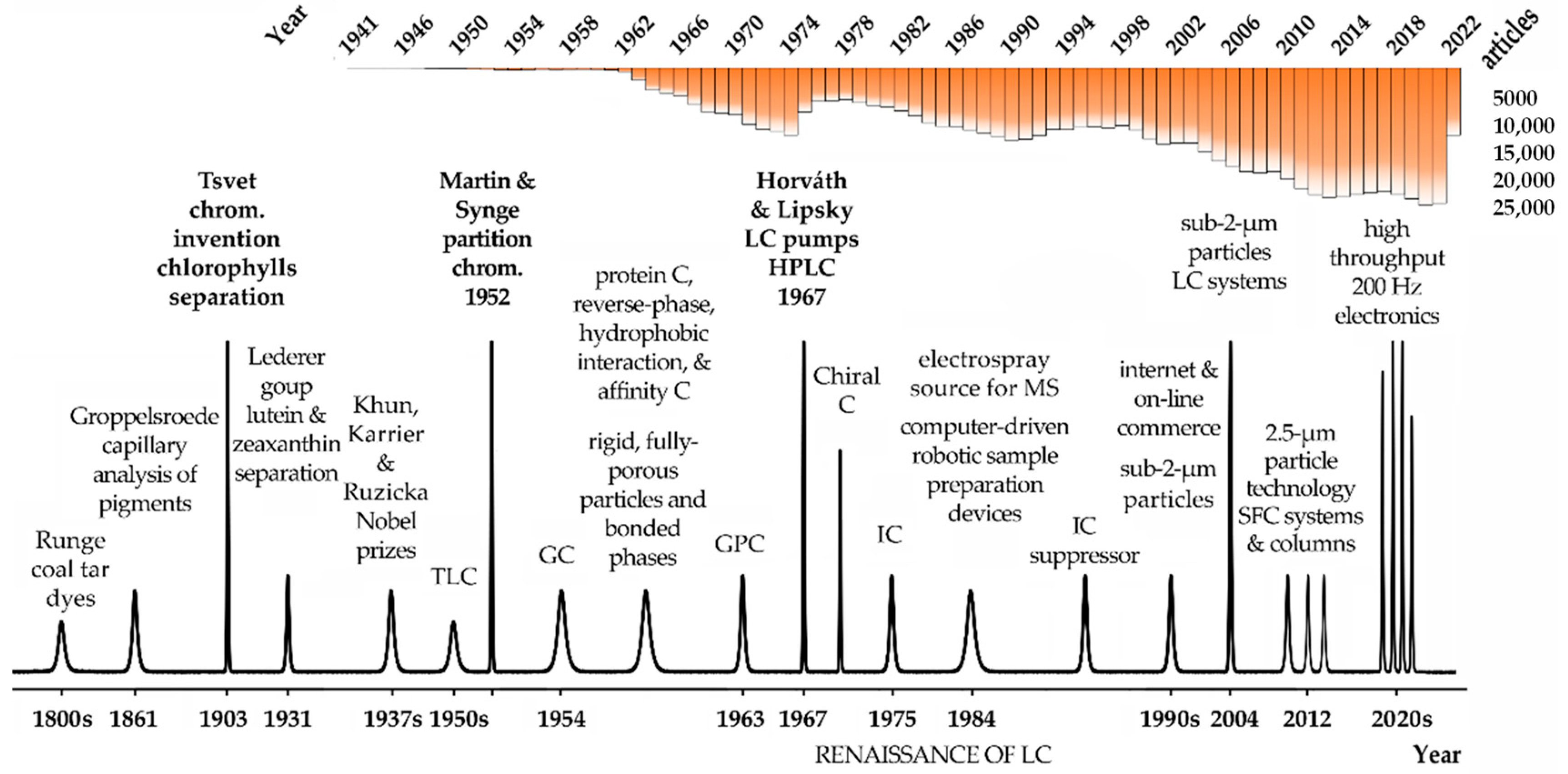
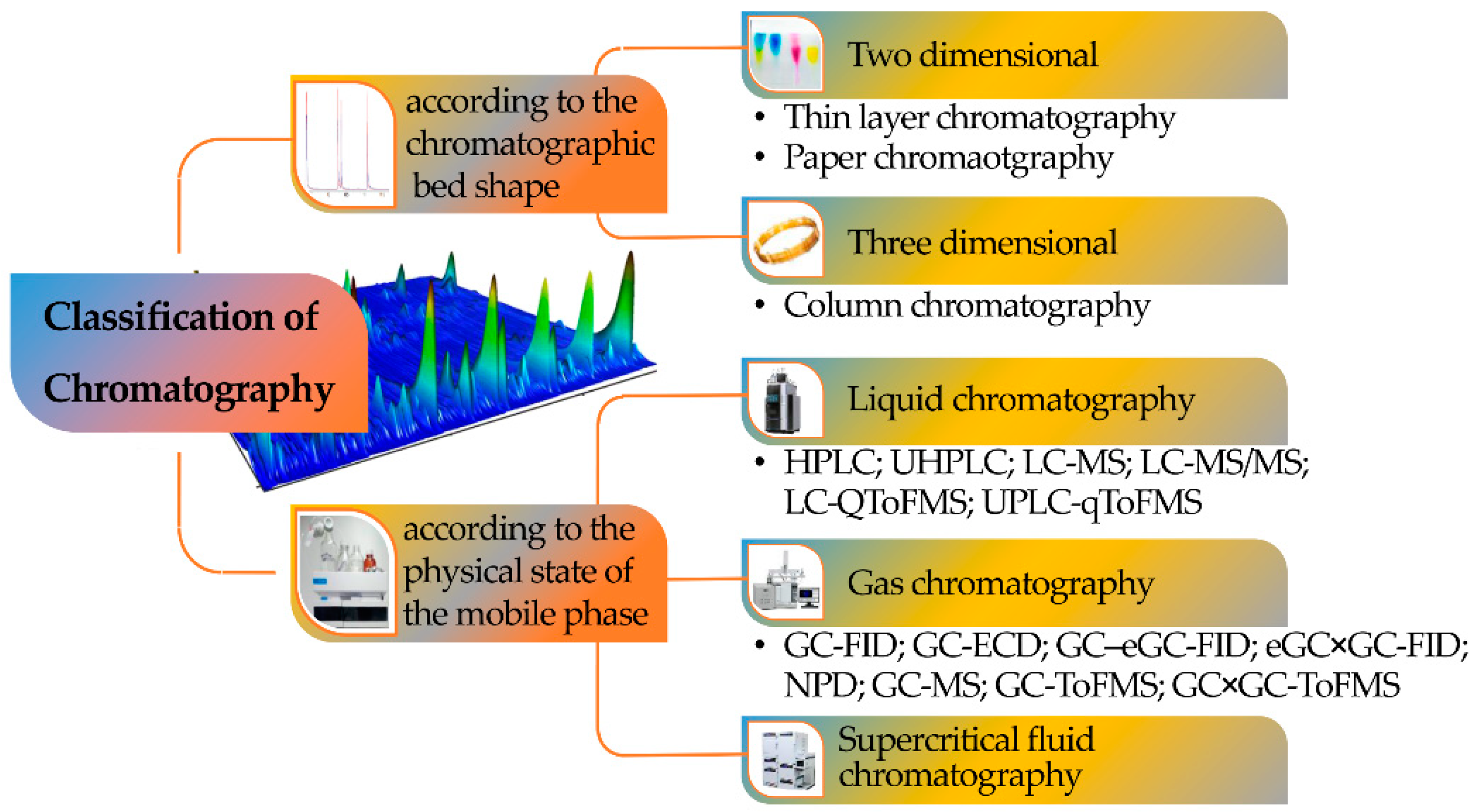
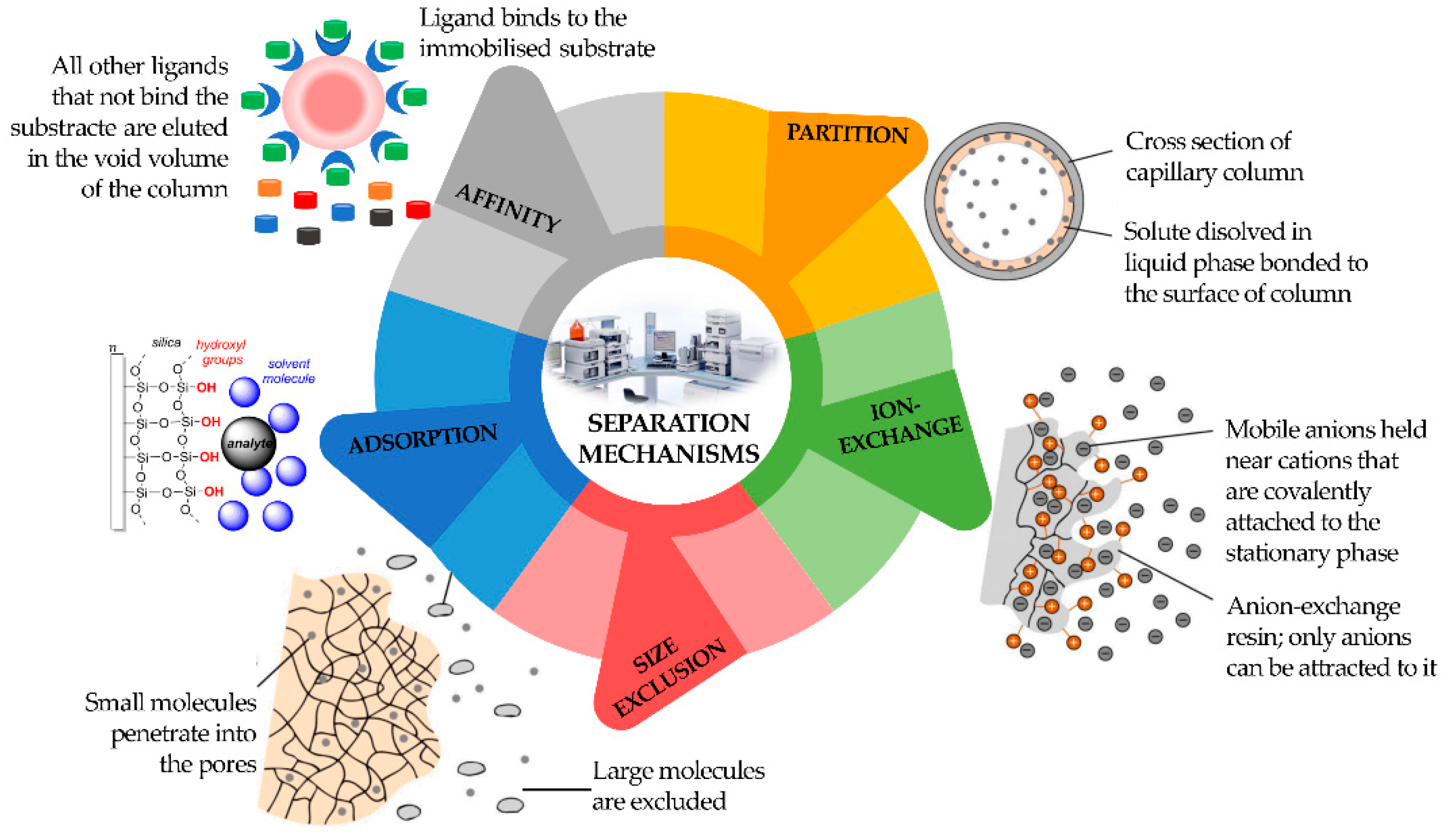
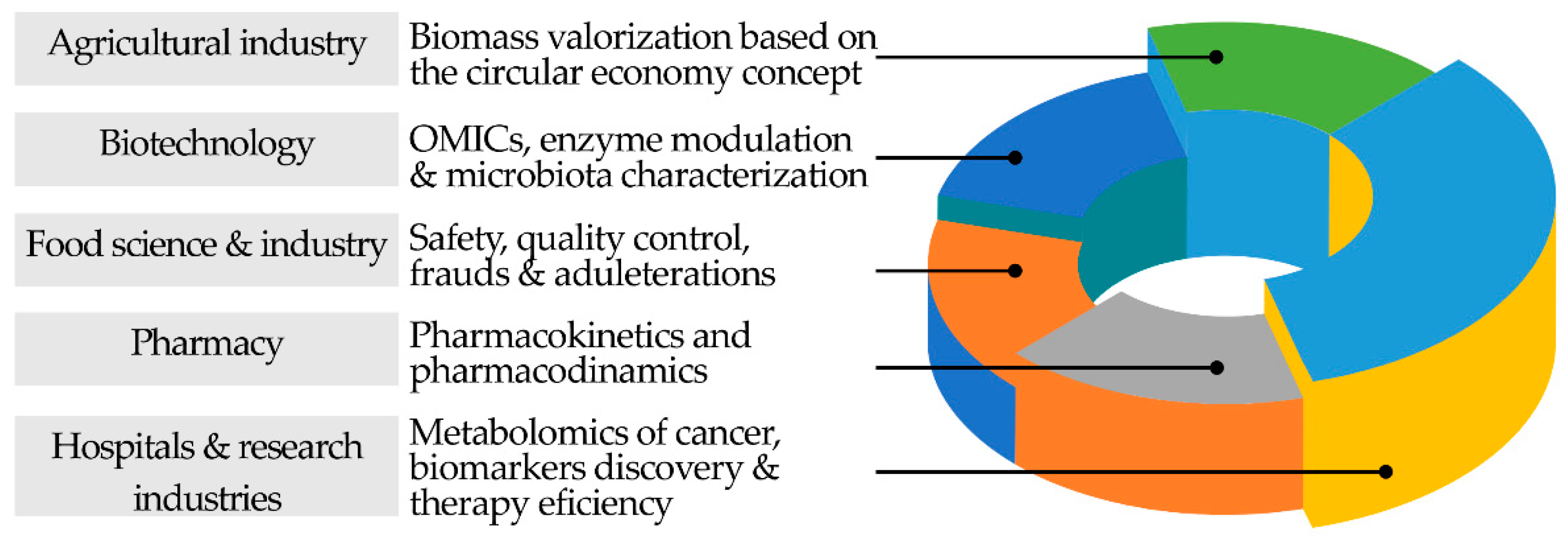
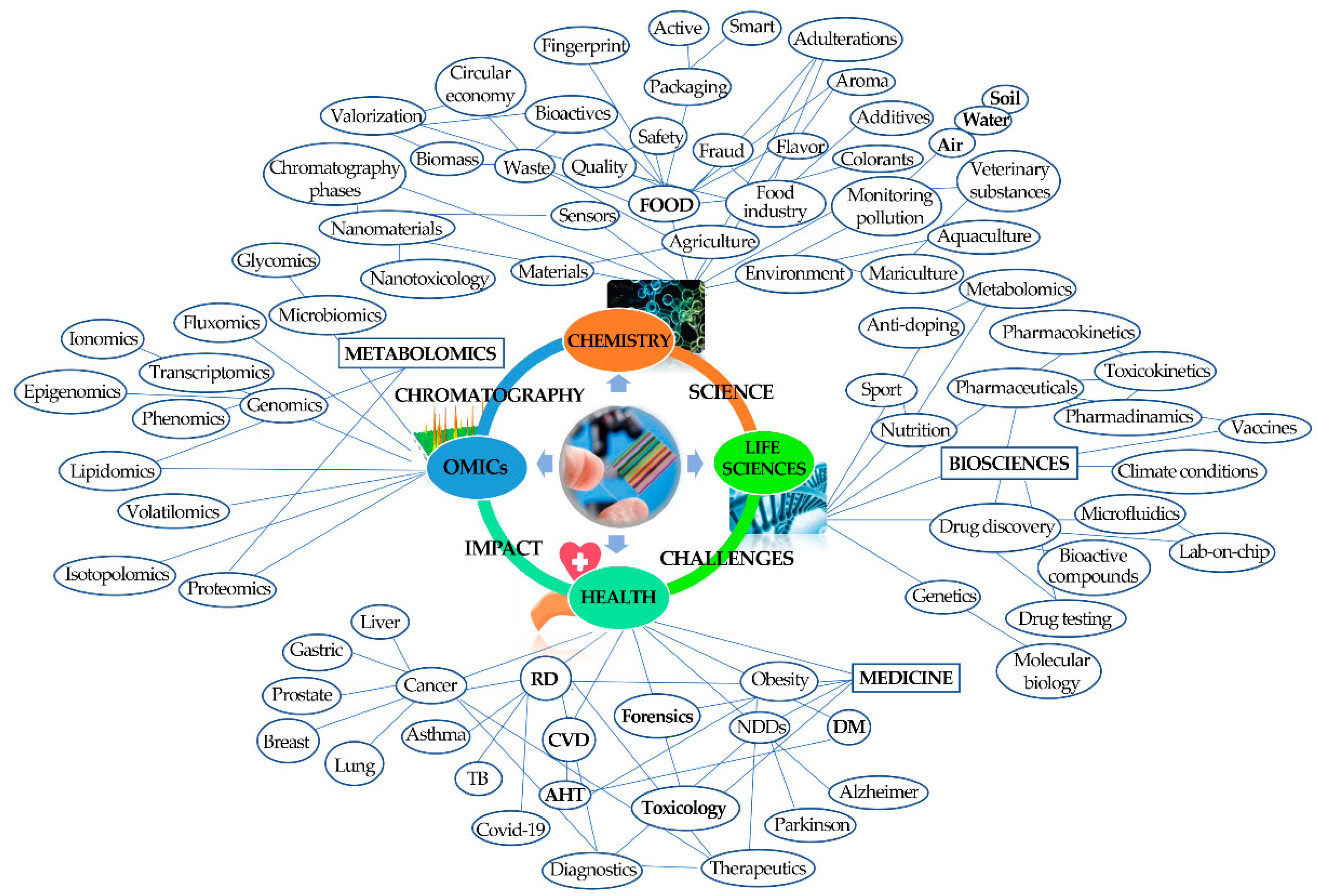
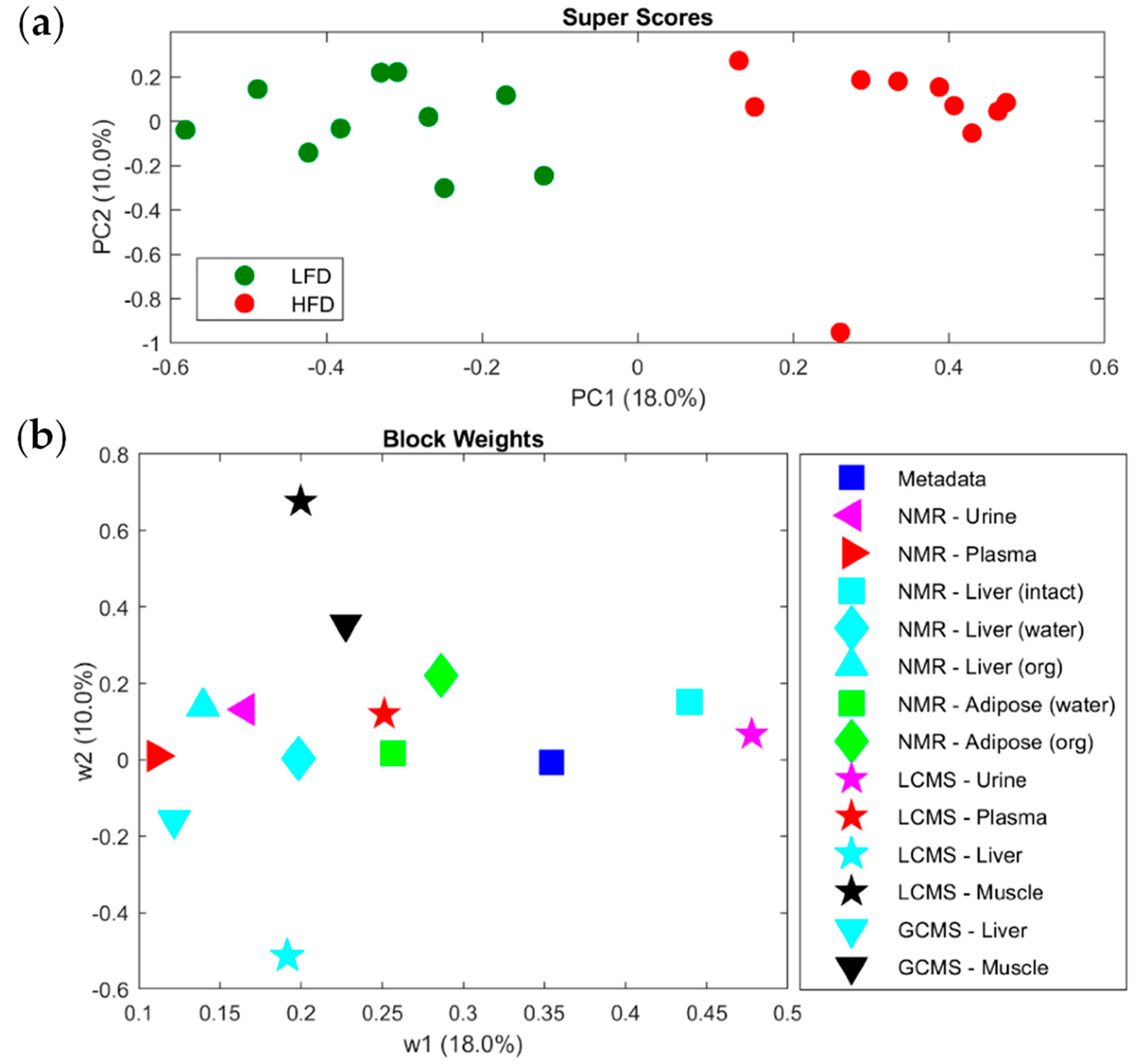
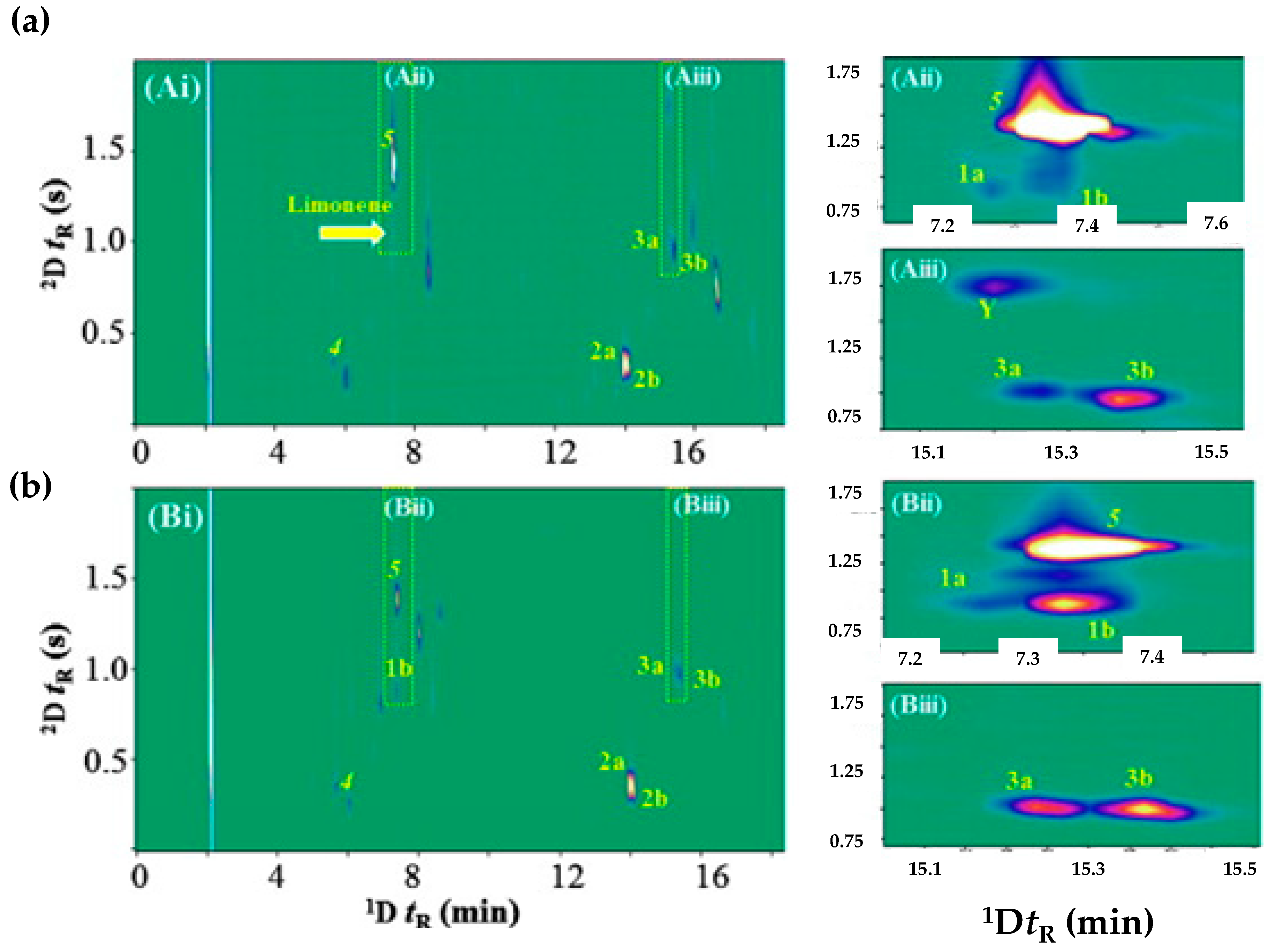
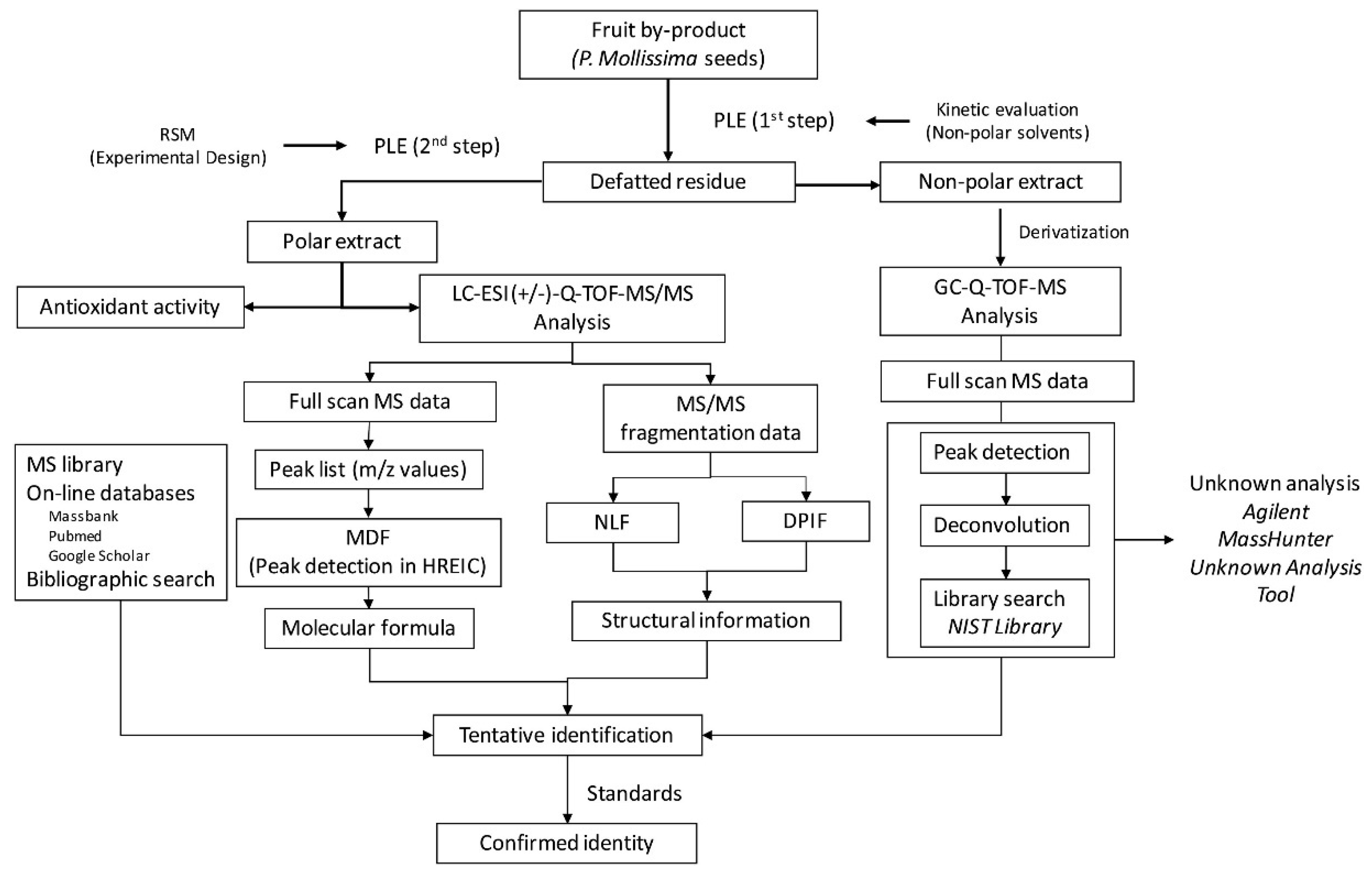
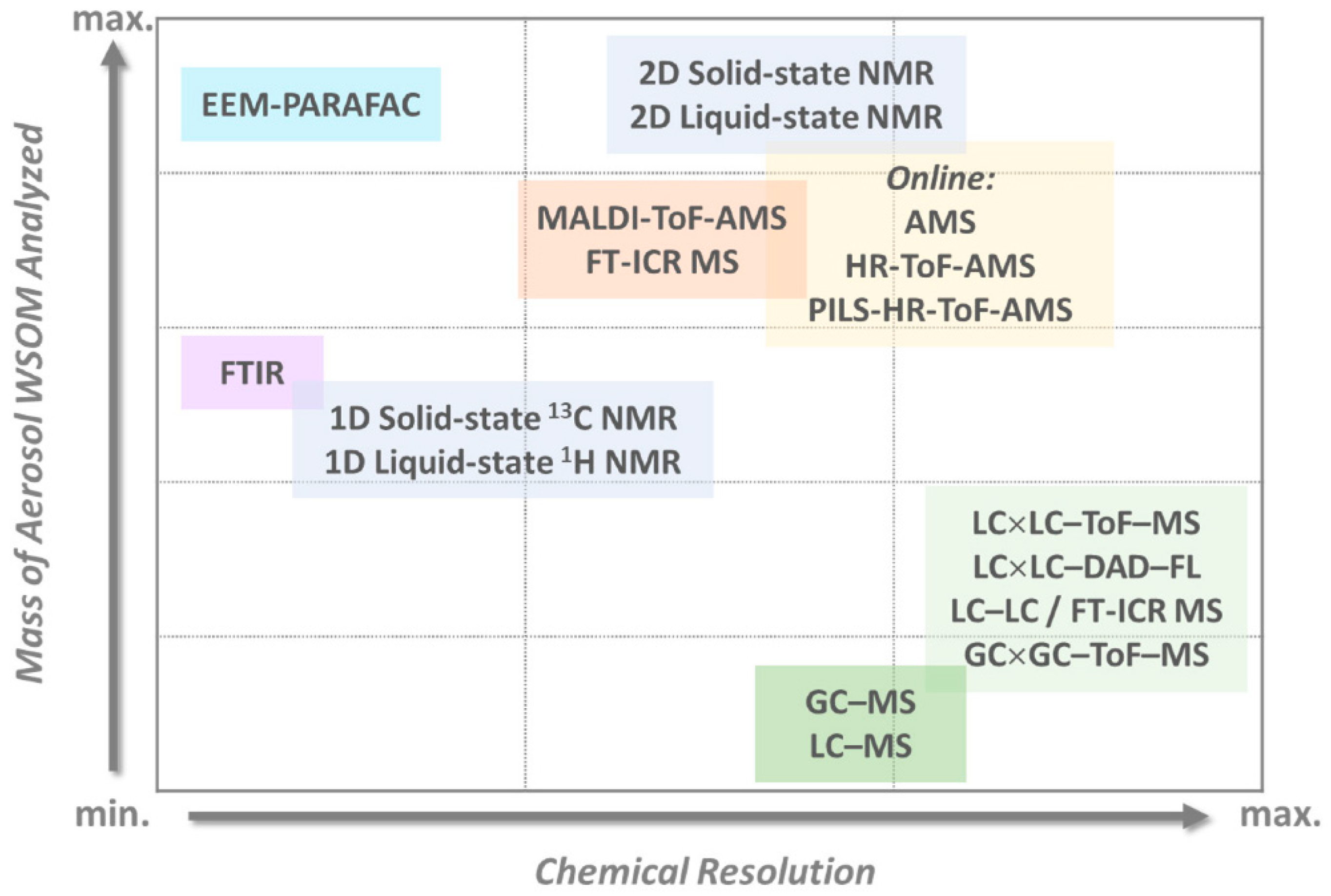
Publisher’s Note: MDPI stays neutral with regard to jurisdictional claims in published maps and institutional affiliations. |
© 2022 by the authors. Licensee MDPI, Basel, Switzerland. This article is an open access article distributed under the terms and conditions of the Creative Commons Attribution (CC BY) license (https://creativecommons.org/licenses/by/4.0/).
Share and Cite
Câmara, J.S.; Martins, C.; Pereira, J.A.M.; Perestrelo, R.; Rocha, S.M. Chromatographic-Based Platforms as New Avenues for Scientific Progress and Sustainability. Molecules 2022, 27, 5267. https://doi.org/10.3390/molecules27165267
Câmara JS, Martins C, Pereira JAM, Perestrelo R, Rocha SM. Chromatographic-Based Platforms as New Avenues for Scientific Progress and Sustainability. Molecules. 2022; 27(16):5267. https://doi.org/10.3390/molecules27165267
Chicago/Turabian StyleCâmara, José S., Cátia Martins, Jorge A. M. Pereira, Rosa Perestrelo, and Sílvia M. Rocha. 2022. "Chromatographic-Based Platforms as New Avenues for Scientific Progress and Sustainability" Molecules 27, no. 16: 5267. https://doi.org/10.3390/molecules27165267
APA StyleCâmara, J. S., Martins, C., Pereira, J. A. M., Perestrelo, R., & Rocha, S. M. (2022). Chromatographic-Based Platforms as New Avenues for Scientific Progress and Sustainability. Molecules, 27(16), 5267. https://doi.org/10.3390/molecules27165267









